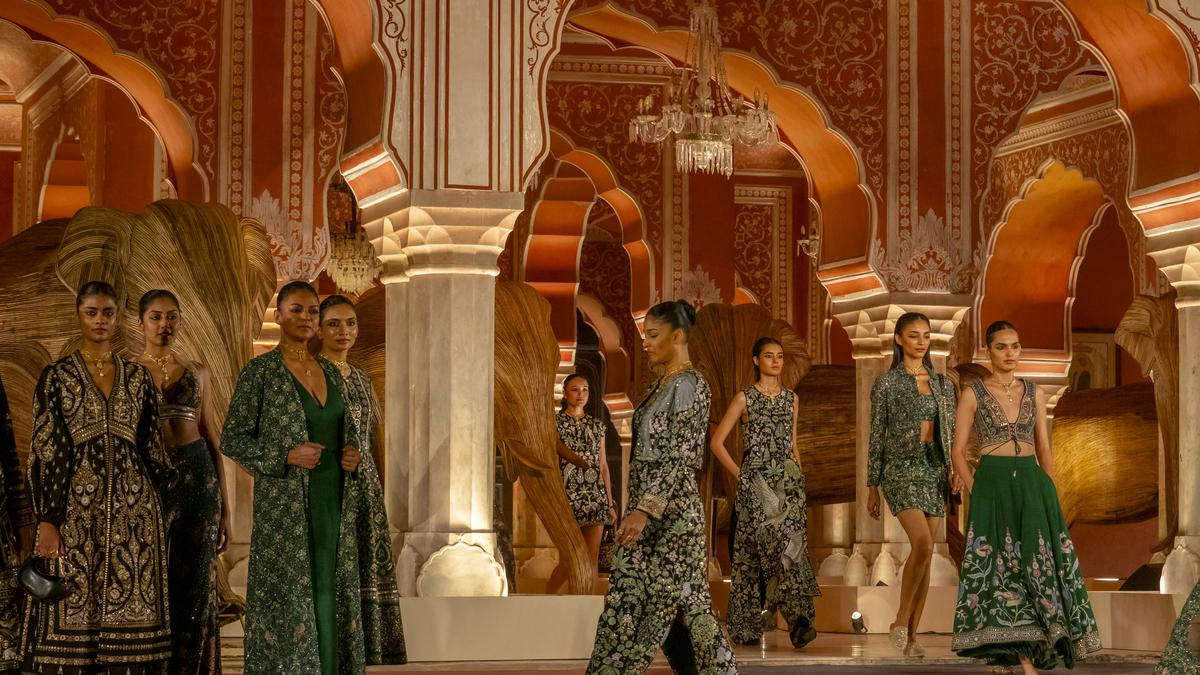
Anita Dongre’s Jaipur takeover with a landmark fashion fundraiser at the iconic City Palace
The Hindu
Anita Dongre held a ‘Rewild’23: Fashion For Good’ fashion fundraiser for elephants at Jaipur’s City Palace recently. The line-up included everything from lehengas, cropped skirts and roomy kurtas to short suits, vest sets and dresses. Traditional folk costumes had a heavy influence on the silhouettes as did indigenous techniques such as embroideries by the female artisans of SEWA, gota patti and hand-painted Pichhwai in flora- and fauna-inspired patterns.
Goosebumps. That is the word most guests used to articulate their experience of witnessing Anita Dongre’s recent couture extravaganza showcased in the sprawling inner courtyard of the iconic City Palace in Jaipur. As I sit down with the otherwise elusive designer at the palace’s Baradari restaurant the next afternoon, she looks visibly content following the landmark presentation she and her team just pulled off. “It has been a long-held dream to have a show here,” she admits. This was a true homecoming for Anita, in many ways.
The Jaipur native, whose brand ethos is heavily steeped in the crafts and culture of Rajasthan, has always turned to her hometown for inspiration. She shot her maiden bridal collection at the City Palace back in 2012. The palace grounds are also where she met pichhwai artist Lekhraj, with whom she has since gone on to collaborate on her pichhwai couture pieces. So, the Rewild’23: Fashion For Good showcase was ultimately a full circle moment over 10 years in the making. With it, Anita became the first-ever designer for whom the erstwhile royal family opened the majestic gates to the pink-washed central courtyard of its 300-year-old home, even co-hosting the fundraiser with her (Rohit Bal’s 2017 show in the palace was in a smaller section).
With a moment this momentous, every little detail had to tie in to tell a larger story of heritage, culture and mindfulness. Traditional folk singers and percussionists were seated on the plinth of the Sarvatobhadra open hall, as nagada drummers on the roof cued in the 76 models. Life-size elephants sculpted from Lantana — a toxic invasive weed destroying Indian forests — lined the arches of the royal runway, and were available for sale in order to raise funds for a better habitat for elephants. The flower-laden tables were dressed in bougainvillea from the palace grounds and homegrown flowers (repurposed for the brunch décor the next day). From the custom print of the table linen right down to the logo stirrers at the bar, no detail was too small for the designer’s keen eye. “The underlying values of sustainability, and of Jaipur and its royalty were of course there. But everything had to tie in visually as well,” explains the 60-year-old designer.
The collection was one that revealed itself as an evolution of the designer’s signature aesthetic; one that may be steeped in the ancient crafts of the country but is cleverly rethought for the modern woman. Anita, who has been a champion of pockets in lehengas and occasion wear sold as separates since her early days, did not waver from her comfort-driven agenda.
The line-up included everything from lehengas, cropped skirts and roomy kurtas to short suits, vest sets and dresses. Traditional folk costumes had a heavy influence on the silhouettes as did indigenous techniques such as embroidery by the female artisans of SEWA, gota patti and hand-painted pichhwai in flora, and fauna-inspired patterns. “I wanted it to have a lot of Indian craft, but at the same time be cool, contemporary and global,” she says. Every look was paired with tie-up ballerinas or slip-on juttis, without a heel in sight. “I’ve always said comfort is above everything else. The collection was meant to have a very luxurious, relaxed ease.”
There is no denying that Anita and her design empire are one of Indian fashion’s biggest success stories. While it remains in the family, they did secure an investment from General Atlantic as early as 2013. Their New York store opened as early as 2018 and Dubai earlier this year. Even so, the designer prefers to remain behind-the-scenes, a rarity in today’s landscape. “It’s not about me. The clothes have to be the stars of what I do. I want to create a legacy that outlives me.”
Anita says she would rather focus on creating more impact with her work — be it with her mindful Grassroot by Anita Dongre line, artisans-led Sewa collection, or the upcoming Grassroot Home with the female artisans of Princess Diya Kumari Foundation for which she is working closely withGauravi Kumari. Ultimately, she believes her raison d’etre stands on the foundation of empathy and empowerment. “I think it’s a huge responsibility to create clothes that allow you to bring your personality to them. It’s empowering,” she says. “My vision is aimed at empowering the wearer, and empowering the maker — the two purposes of our business, she concludes.













